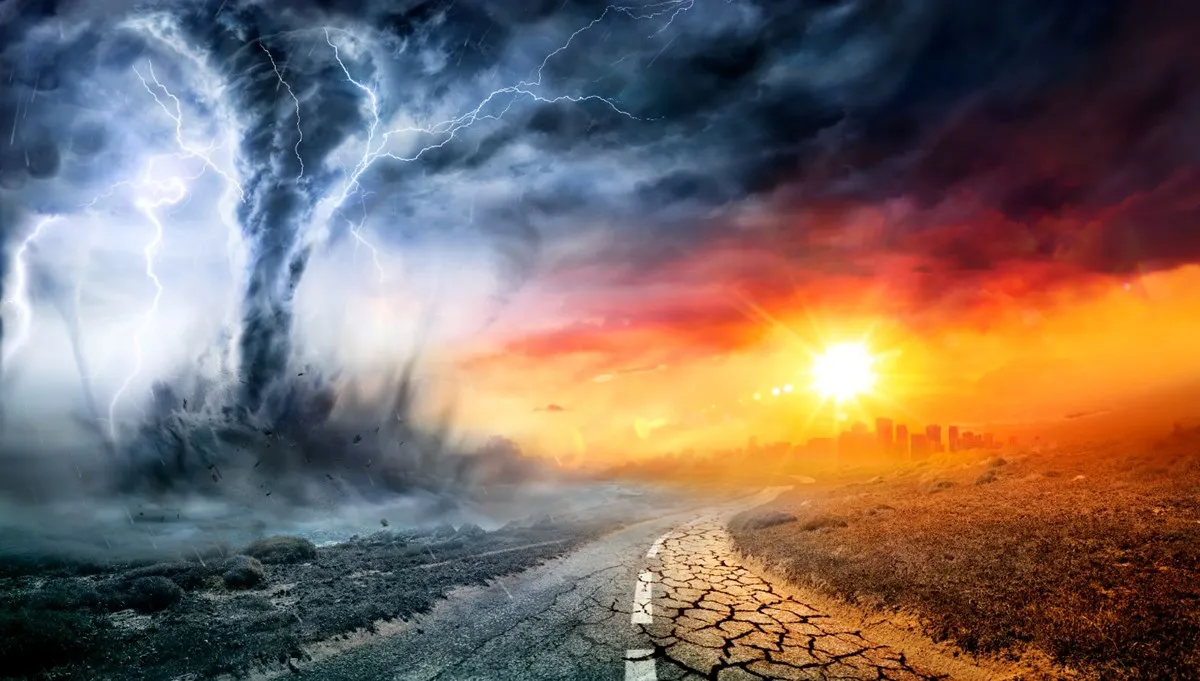Science
Exploring the Connection between Soil Health and Sustainable Agriculture

Soil is the foundation of sustainable agriculture. Without healthy soil, crops cannot grow and thrive, leading to reduced yields and even crop failure. That’s why it’s essential to understand the connection between soil health and sustainable agriculture. In this blog post, we’ll explore how improving soil health can lead to more efficient and effective farming practices that benefit both farmers and the environment. We’ll also provide tips on how you can improve your own soil health for a healthier planet!
The Importance of Soil Health
Soil health is critical for the success of any agricultural system. Healthy soil not only provides a fertile environment for crops to grow but also plays an essential role in protecting our environment.
Healthy soil contains nutrients that are vital for plant growth, such as nitrogen, phosphorus, and potassium. These nutrients come from organic matter and other sources present in the soil. The presence of these nutrients helps plants to grow faster and stronger, leading to higher yields.
Soil health also affects water quality. Soil acts as a filter by removing pollutants from runoff before it enters waterways. It can reduce erosion and improve water infiltration into the ground, which can help mitigate flooding during heavy rainfall events.
Healthy soil supports biodiversity by providing habitats for various organisms such as worms, insects, fungi and microorganisms that play important roles in nutrient cycling and pest control.
In summary, soil health is integral to sustainable agriculture because it supports crop growth while protecting our precious natural resources like clean air and water.
The Relationship between Soil Health and Sustainable Agriculture
The connection between soil health and sustainable agriculture is undeniable. Sustainable agriculture aims to meet the needs of current generations without compromising future ones, while soil health refers to the ability of soil ecosystems to sustainably support plant growth. When we focus on improving soil health through sustainable agricultural practices, we are creating a positive feedback loop that benefits both the environment and our food systems.
By using methods such as crop rotation, cover cropping, and reduced tillage, farmers can improve the structure and fertility of their soils. This not only leads to better yields but also helps prevent erosion and nutrient runoff into nearby water sources.
Healthy soils contain a diverse community of microorganisms that work together with plants to promote healthy growth. By promoting biodiversity in our farming systems, we can enhance these beneficial relationships and reduce reliance on synthetic fertilizers and pesticides.
Additionally, sustainable agricultural practices like integrated pest management (IPM) use natural predators rather than harmful chemicals to control pests. This reduces harm to non-targeted species while still effectively protecting crops.
In short, caring for the health of our soils is essential if we want to create a truly sustainable agricultural system. When we prioritize regenerative farming practices that nurture this vital resource rather than deplete it, we pave the way for a healthier planet for generations to come.
How to Improve Soil Health
Improving soil health is essential for sustainable agriculture practices. Here are some ways to achieve this.
1. Use Cover Crops: Planting cover crops help in reducing soil erosion, weed growth and also improves the nutrient content of the soil.
2. Rotate Crops: Crop rotation helps to prevent pests and diseases from building up in the soil while also increasing organic matter levels.
3. Minimize Tillage: Reducing tillage minimizes disturbance to the soil structure, increases water retention capacity and enhances biological activity.
4. Add Organic Matter: Compost or manure can be incorporated into soils to improve its physical properties by adding nutrients necessary for plant growth.
5. Use Natural Fertilizers: Chemical fertilizers cause harm to beneficial microorganisms present in soils that maintain healthy ecosystems; natural fertilizers like bone meal and blood meal provide similar benefits without harming microbes.
Incorporating these practices can improve overall crop yield while minimizing inputs such as chemical fertilizers or pesticides, making it cost-effective for farmers who want an eco-friendly approach towards farming practices.
The Benefits of Improved Soil Health
Improving soil health is beneficial for both the environment and agriculture. When the soil is healthy, it can sustainably support plant growth while reducing various negative impacts on natural ecosystems. Here are some benefits of improved soil health:
1. Increased crop yield: Soil with better structure, fertility, and moisture retention capacity can promote plant growth and improve crop yields.
2. Improved water quality: Healthy soil acts as a filter that prevents contaminants from entering groundwater or surface water sources. Maintaining good soil health reduces the risk of nutrient runoff or erosion that can harm aquatic ecosystems.
3. Enhanced biodiversity: Improving soil health also increases biodiversity by creating habitats for microorganisms such as bacteria, fungi, nematodes, and earthworms. These organisms contribute to nutrient cycling and biological control in the ecosystem.
4. Reduced greenhouse gas emissions: Healthy soils store carbon in organic matter which helps reduce atmospheric carbon levels responsible for climate change.
5. Cost savings: Good soil management practices lower costs associated with chemical inputs and energy use while improving overall productivity.
Investing in improving soil health is an essential component of sustainable agriculture practices that benefit farmers along with broader environmental conservation efforts aimed at mitigating climate change impacts while protecting natural resources over time
Conclusion
Soil health is essential to sustainable agriculture. It’s a vital component of the ecosystem and plays a significant role in ensuring food security for future generations. Farmers who prioritize soil health will see improvements in crop yields, pest management, and overall farm productivity.
Improving soil health requires a long-term approach that focuses on nurturing the biological diversity of the soil. By practicing regenerative practices such as crop rotation, cover cropping, and reduced tillage, farmers can build resilient soils that retain moisture, sequester carbon, and support beneficial microorganisms.
The benefits of improving soil health are numerous. Healthy soils increase biodiversity above ground by providing habitat for pollinators and other beneficial insects while reducing nutrient runoff into waterways. Additionally, healthy soils mitigate climate change effects by storing more carbon than degraded soils.
It’s critical to recognize the connection between soil health and sustainable agriculture. By prioritizing soil conservation practices on farms globally – we can ensure that our world’s food supply is both nutritious and abundant without compromising natural resources or human well-being.
News
Unbelievable Sword From 3000 Years Ago Uncovered Intact!

Introduction
Archaeology never fails to amaze. Imagine unearthing a weapon that hasn’t seen battle for three millennia—yet remains almost pristine. That’s exactly what happened when experts realized a sword in Chicago’s Field Museum, long thought to be a replica, is actually a genuine 3,000‑year‑old sword. At the same time, excavations in southern Germany’s Bavaria region uncovered another Bronze Age blade so well preserved it “almost still shines.” These finds rewrite parts of European Bronze Age history and offer a rare glimpse into ancient metalworking prowess. In this article, we take you behind the scenes of these incredible discoveries, explore how these swords survived intact, and explain why they matter today.
A Sword Mistaken for a Replica—Until Now
The Chicago Field Museum Surprise
One of the Field Museum’s most famous weapons—on display for decades—was believed to be a modern copy of a Bronze Age sword from the Danube region in Hungary. The sword, discovered in the 1930s in the Danube River near Budapest, sat in the museum’s collection as a replica, its true origins forgotten.
In July 2025, Hungarian archaeologists curating the “First Kings of Europe” exhibition began to suspect the sword’s alloy and patina didn’t match a modern forgery. Advanced testing using X‑ray fluorescence (XRF) analysis revealed an alloy composition of copper, tin, and trace elements perfectly matching Late Bronze Age metallurgy. The results dated the sword to between 1080 BCE and 900 BCE—making it over 3,000 years old and a once‑in‑a‑lifetime find DailyNewsHungary.
Why It Matters
- Preservation: The sword’s burial in river sediments and low‑oxygen water slowed corrosion, leaving the blade and handle corrosion‑free.
- Craftsmanship: Metallurgists note the even alloy mix and fine casting, indicating skilled smiths in Bronze Age Hungary.
- Cultural Context: As a deadly weapon, it speaks to the power and prestige of its owner, likely a local chieftain or warrior elite.
This rediscovery underscores the importance of reexamining museum collections with modern techniques—history’s treasures can hide in plain sight.
The Bavaria Blade That “Almost Still Shines”
Discovery in Nördlingen
In June 2023, archaeologists excavating a Bronze Age grave in Nördlingen, Bavaria, uncovered a sword alongside the remains of a man, woman, and child. Per Bavaria’s State Office for Monument Protection, the octagonal bronze hilt was cast directly over the blade in a single pour—an advanced technique practiced only by master smiths around the end of the 14th century BCE Smithsonian Magazine.
Key Features
- Octagonal Hilt: Rare design that required precision casting over the blade to ensure balance and durability.
- Pristine Condition: The sword shows no signs of battlefield damage, suggesting it may have been a ceremonial or high‑status object rather than a frontline weapon.
- Metallurgical Marvel: Analysis reveals a center of gravity optimized for slashing, meaning it could function as a real weapon if needed.
This Bavarian find is so well preserved that its surface reflects light—earning it the description “almost still shining.” It highlights how cold, alkaline soils can slow bronze corrosion, leaving intricate artifacts intact for millennia.
How Bronze Age Swords Survived Intact
1. Burial Environment
- Low Oxygen: Submersion in water or burial in dense clay creates an anaerobic environment, limiting oxidation and corrosion.
- Stable pH: Neutral to slightly alkaline soils help preserve metal objects by preventing acid‑driven degradation.
2. Metallurgy and Casting
- High‑Tin Bronze: A tin content of around 10–12% yielded a harder, more corrosion‑resistant alloy.
- Protective Patina: A thin, stable layer of copper oxide forms naturally, shielding the metal beneath from further decay.
3. Human Care
- Grave Goods Context: Swords buried with their owners were seldom disturbed by grave robbers, especially in remote or secret burial sites.
- Early Ceremonial Use: Some blades were placed intentionally unused—perhaps as offerings—limiting wear and damage.
Together, these factors allowed certain Bronze Age swords to endure for thousands of years, waiting to be rediscovered.
What These Swords Tell Us About Bronze Age Europe
Metallurgical Expertise
Both the Hungarian and Bavarian swords demonstrate that Bronze Age smiths possessed advanced knowledge of alloy composition and casting techniques. Octagonal hilts cast directly onto blades required precise temperature control and mold design—a testament to the era’s technical sophistication.
Social Structures
High‑quality weapons like these likely belonged to elites—warrior‑nobles or chieftains—who used them as status symbols. The decision to bury such swords intact suggests ritual importance, linking martial power with beliefs about the afterlife.
Trade and Interaction
The alloy components—copper from one region, tin from another—point to long‑distance trade networks across Europe. These networks supplied raw materials to specialized workshops, fostering cultural exchange and technological diffusion across the continent.
Modern Methods Reveal Ancient Secrets
Today’s archaeologists use an array of tools to study such artifacts:
- X‑Ray Fluorescence (XRF): Non‑destructive elemental analysis reveals alloy composition with pinpoint accuracy.
- 3D Laser Scanning: Creates detailed digital models of swords, preserving their shape and surface features for study and public display.
- Microscopic Imaging: Examines casting lines and tool marks to reconstruct ancient forging and finishing processes.
- Accelerator Mass Spectrometry (AMS) Dating: Carbon‑14 dating of associated organic materials (like wood or leather) provides precise burial dates.
These methods allow researchers to peer directly into the manufacturing choices and burial contexts of ancient societies.
Display and Preservation Today
Once analyzed, such swords undergo careful conservation:
- Stabilization: Mild chemical treatments remove corrosive salts without harming the patina.
- Controlled Environment: Museum cases maintain stable humidity (around 40–50%) and temperature (18–20 °C) to prevent further decay.
- Interpretive Exhibits: Display panels and interactive kiosks share the swords’ stories—how they were made, what they meant, and why their discovery matters.
In Chicago, the newly authenticated Hungarian sword will join Field Museum exhibits on European prehistory, while the Bavarian blade shines in regional museums, captivating visitors with its near‑perfect preservation.
Why These Discoveries Matter
- Cultural Heritage: They connect us to ancestors whose lives and beliefs shaped modern Europe.
- Technological Insight: Understanding Bronze Age metallurgy informs fields from materials science to historical linguistics.
- Public Engagement: Such finds ignite curiosity and support for archaeological research, leading to new discoveries across the globe.
Every intact artifact recovered after millennia becomes a bridge between past and present—an opportunity to learn, wonder, and preserve heritage for future generations.
Conclusion
The revelation that a sword in Chicago once dismissed as a replica is a 3,000‑year‑old masterpiece—and the discovery of a near‑shining Bavarian blade—remind us how the past can lie hidden in plain sight. These Bronze Age swords showcase extraordinary smithing skill, long‑distance trade, and deep ritual meaning. Thanks to modern archaeological science, we can now study their metals, shapes, and contexts in stunning detail. As these ancient swords take their place in museums, they will continue inspiring awe and curiosity—proof that, after three millennia, true craftsmanship endures. For archaeologists and enthusiasts alike, each discovery uncovers a new chapter in humanity’s shared story.
Science
The UCoping with Climate Disasters as the ‘New Normal’

Introduction
Climate disasters—such as wildfires, floods, hurricanes, and heatwaves—are becoming the new normal in many parts of the world. These events disrupt lives, damage homes, and threaten communities. Learning coping with climate disasters is no longer optional. It is a vital skill for everyone, from families and schools to businesses and governments. In this article, we explore why these disasters are increasing, how they affect people, and 15 practical strategies to prepare, adapt, and stay resilient. By taking action now, we can protect ourselves and our communities from future shocks.
Why Climate Disasters Are the New Normal
Rising Temperatures and Extreme Weather
Earth’s average temperature has risen by about 1.2°C (2.2°F) since pre-industrial times. Warmer air holds more moisture, fueling stronger storms and floods. Heatwaves become longer and more intense. Droughts spread across regions that once had reliable rainfall. These shifting patterns make climate disasters more common and severe.
Human Impact and Urban Growth
As cities expand, more people live in high-risk zones such as flood plains and coastal areas. Infrastructure struggles to keep pace with rapid growth. When a disaster strikes, dense populations and weak planning heighten the toll on lives and property.
Feedback Loops and Cascading Effects
Disasters can trigger further risks. For example, severe drought weakens forests, making them prone to wildfires. Fires release carbon, which warms the planet further. Floods can damage water treatment plants, leading to disease outbreaks. Understanding these cascading effects helps us see the need for strong coping measures.
Common Types of Climate Disasters
- Wildfires: Fueled by heat and dry conditions, they spread rapidly through forests and urban edges.
- Floods: Heavy rains or storm surges can overwhelm rivers and coastal defenses.
- Hurricanes and Cyclones: Powerful winds and rain cause widespread damage.
- Heatwaves: Extended periods of high temperatures strain health and infrastructure.
- Droughts: Lack of rainfall harms crops, water supplies, and livelihoods.
By recognizing these threats, communities can focus on targeted coping with climate disasters strategies.
Impacts on People and Communities
Physical and Economic Damage
Homes, roads, and power lines can be destroyed in hours. Businesses may close for weeks or months. Repairs and rebuilding strain personal finances and local economies.
Health and Well-Being
Heatwaves increase heatstroke and dehydration risks, especially for the elderly and very young. Floodwaters can carry pollutants, causing infections. Wildfire smoke worsens respiratory conditions. Mental health can suffer after repeated losses or prolonged stress.
Social and Cultural Disruption
Disasters may force people to evacuate, leaving them separated from family, work, and community networks. Cultural landmarks and heritage sites can be lost forever. Schools and community centers may shut down, disrupting daily life.
15 Science-Backed Tips for Coping with Climate Disasters
1. Develop a Family Emergency Plan
- Communication: Choose a meeting spot and share important contacts.
- Roles: Assign tasks such as gathering supplies or securing pets.
- Practice Drills: Run through scenarios at least twice a year.
2. Build an Emergency Kit
Include items like water (one gallon per person per day), nonperishable food, flashlights, batteries, a first-aid kit, necessary medications, and copies of important documents. Update the kit every six months.
3. Monitor Weather Alerts
Sign up for local emergency alerts via text or app. Install a NOAA weather radio with tone alert. React immediately to evacuation orders or flood warnings.
4. Reinforce Your Home
- Hurricane Straps: Strengthen roof connections.
- Flood Barriers: Install sandbags or permanent flood shields.
- Fire-Resistant Materials: Use metal or tile roofs and noncombustible siding in wildfire zones.
5. Improve Landscaping for Safety
Keep trees trimmed and clear dead leaves around your property. In fire-prone areas, maintain a defensible space of at least 30 feet around structures. Along rivers, plant deep-rooted native vegetation to reduce erosion.
6. Upgrade Critical Systems
Install a backup power generator or solar-plus-battery system. Elevate HVAC units above expected flood levels. Use flood-proof vents to allow water to flow without damaging foundations.
7. Strengthen Community Networks
Join or form neighborhood groups focused on resilience. Share tools, resources, and skills. After a disaster, neighbors can check on each other faster than outside responders.
8. Practice Water Conservation
In drought-prone regions, install low-flow fixtures and drought-tolerant plants. Harvest rainwater for gardens. Conserving water helps maintain reserves during extreme heat and drought.
9. Invest in Health Preparedness
Stock personal cooling items like fans and lightweight clothing. Learn basic first aid and CPR. Keep mental health hotlines and local support groups’ numbers on hand.
10. Embrace Nature-Based Solutions
Restore wetlands to absorb floodwaters. Reforest hillsides to stabilize soil and reduce landslides. These natural buffers can be more cost-effective than concrete barriers.
11. Secure Your Finances
Review insurance policies for flood, fire, or wind damage coverage. Consider an emergency fund of three to six months’ living expenses. Ensure important financial records are backed up off-site.
12. Stay Informed on Policy and Aid Programs
Governments often offer grants or low-interest loans to repair disaster damage. Nonprofits and community organizations may provide free or subsidized home-hardening services.
13. Reduce Your Carbon Footprint
While individual actions alone cannot stop climate change, they add up. Use public transit, eat more plant-based meals, and support renewable energy. Lowering emissions helps slow the pace of extreme events.
14. Plan for Long-Term Adaptation
Consider relocating if you live in a repeatedly flooded or fire-prone area. Evaluate safer, more stable regions and factor climate risks into real estate decisions.
15. Advocate for Stronger Infrastructure
Vote for bonds or policies that invest in resilient roads, bridges, stormwater systems, and power grids. Community-wide upgrades protect more people at lower per-person cost.
Mental Health and Emotional Resilience
Facing frequent disasters can take a mental toll. Build emotional strength by:
- Staying Connected: Lean on friends, family, and support groups.
- Mindfulness Practices: Meditation, yoga, or deep breathing can reduce anxiety.
- Professional Support: Counselors or peer-support networks can help process trauma.
- Routine and Purpose: Keeping a regular schedule and helping others both boost well-being.
Role of Policy and Community Planning
Smart Zoning and Building Codes
Municipalities can require new buildings to meet flood, wind, and fire standards. Zoning laws can discourage development in high-risk zones.
Early Warning Systems
Investing in robust detection and communication networks—such as sensors, sirens, and mass-notification apps—gives communities more time to act.
Green Infrastructure
Cities can build rain gardens, permeable pavements, and urban forests to manage stormwater and reduce heat islands. Such measures also improve air quality and quality of life.
Embracing the New Normal
Accepting that climate disasters are part of our reality motivates action. By combining personal preparedness, community resilience, and smart policy, we can reduce harm and rebuild stronger. Each step—from bolstering your home to voting for green infrastructure—adds up to a safer future for all.
Conclusion
Coping with climate disasters as the new normal calls for clear planning, smart investments, and community spirit. From creating an emergency plan to advocating for resilient infrastructure, every action counts. By following these 15 practical tips, you can protect your family, support your neighbors, and help build a world ready for the challenges ahead. Together, we can transform threat into opportunity—emerging stronger, wiser, and more connected than ever before.
Science
Emperor Penguins’ Struggle: Vanishing Chicks Amid Melting Ice

Introduction
Across Antarctica’s frozen expanse, emperor penguins march in tight colonies. These majestic birds, the largest of all penguins, rely on stable sea ice to breed and raise their young. But today, rising temperatures are breaking apart that ice. Melting ice means fewer safe places for chicks to grow strong. As the ice vanishes, so do countless penguin chicks. In this article, we explore how melting ice endangers emperor penguins, why chick survival is at stake, and what steps we can take to help these iconic birds.
The Crucial Role of Sea Ice
Sea ice is more than a cold surface—it’s a nursery, a meeting ground, and a hunting platform.
- Breeding Ground: Adult penguins huddle on stable ice to lay and incubate eggs.
- Chick Safety: Chicks remain on the ice before they are ready to swim.
- Access to Food: Near the ice edge, adults dive for fish and krill to feed hungry chicks.
When ice forms late or melts early, penguins lose their breeding sites. Unstable ice can trap chicks or force parents to abandon nests. Over time, colonies shrink as fewer chicks survive to join the adult population.
Why Ice Is Melting Faster
Climate change is reshaping Antarctica’s landscape. Here’s how:
- Rising Air Temperatures: Warmer air melts ice from above.
- Warming Oceans: Hotter waters weaken ice from below.
- Changing Winds: Shifts in wind patterns push ice away from coasts.
- Increased Rain: Rain on ice makes it brittle and prone to break.
Each factor speeds up ice loss. As ice breaks apart, colonies can be stranded on smaller floes or swept into open water during storms. This leaves eggs and chicks exposed to cold and predators.
Impact on Chick Survival

Image by: Yandex.com
Chicks depend on steady ice for at least three months. Without it, mortality soars.
- Exposure to Cold: Melted ice pools around nests, chilling eggs and chicks.
- Starvation: Long swims to find food tire parents and chicks.
- Predation: Open water invites skuas and seals that prey on vulnerable chicks.
Studies show that in years with poor ice conditions, up to 90% of chicks may not survive. This rapid loss can push colonies toward collapse within decades.
Observed Colony Declines
Researchers monitor penguin colonies across Antarctica. Recent findings reveal:
- Rapid Drops in Numbers: Some colonies have lost more than half their population in 20 years.
- Local Extinctions: In areas where ice completely failed, colonies vanished entirely.
- Shifting Locations: Penguins sometimes move hundreds of miles to find more stable ice.
These shifts strain smaller colonies, which may lack space or food. As prime breeding sites disappear, all emperor penguins face a tougher fight for survival.
How Penguins Are (Barely) Adapting
Emperor penguins have remarkable resilience. They try to cope by:
- Breeding Later: Waiting for more ice to form before nesting.
- Clustering Tighter: Huddling in larger groups to share warmth.
- Longer Foraging Trips: Swimming farther to reach food—but this risks exhaustion.
- New Routes: Finding alternate ice platforms, though these are often scarce.
While these tactics help some birds, they come at a cost. Extended foraging leaves chicks alone longer. Later breeding shortens the growing season, pushing chicks into early winter when storms hit hardest.
Conservation and Research Efforts
Scientists, conservationists, and governments are acting to slow losses:
- Marine Protected Areas: Creating zones where fishing and shipping are limited to protect penguin food sources.
- Climate Policy: Pushing for global emissions cuts to slow warming trends.
- Monitoring Programs: Using satellite imagery to track ice conditions and colony health.
- Public Awareness: Sharing stories and images to build support for penguin preservation.
- Rescue Initiatives: In rare cases, relocating at-risk colonies to safer ice floes.
These measures aim to buy time. But without strong action on climate change, they may only delay the inevitable for some colonies.
The Human Connection
Emperor penguins are a bellwether for our planet’s health. Their struggle reminds us that:
- Our Choices Matter: Reducing carbon footprints can slow ice melt.
- Ecosystems Are Linked: What affects Antarctic ice also influences global sea levels.
- Voices Make Change: Supporting policies and organizations gives scientists tools to act.
By learning about these birds, we see how our actions ripple through the natural world. Helping emperor penguins helps everyone who depends on a stable climate.
Conclusion
Emperor penguins face an uphill battle as melting ice eats away their breeding grounds. Chick survival drops when ice forms late or vanishes too soon. While these birds display incredible resilience—breeding later, huddling closer, and seeking new ice—their efforts may not keep pace with rapid climate change. Protecting emperor penguins means protecting our own future. We must support strong climate policies, expand marine protection, and raise awareness. Only then can we hope to see future generations of emperor penguin chicks thrive on the ice they call home.
-
Business2 years ago
Cybersecurity Consulting Company SequelNet Provides Critical IT Support Services to Medical Billing Firm, Medical Optimum
-
Business2 years ago
Team Communication Software Transforms Operations at Finance Innovate
-
Business2 years ago
Project Management Tool Transforms Long Island Business
-
Business2 years ago
How Alleviate Poverty Utilized IPPBX’s All-in-One Solution to Transform Lives in New York City
-
health3 years ago
Breast Cancer: The Imperative Role of Mammograms in Screening and Early Detection
-
Sports3 years ago
Unstoppable Collaboration: D.C.’s Citi Open and Silicon Valley Classic Unite to Propel Women’s Tennis to New Heights
-
Art /Entertainment3 years ago
Embracing Renewal: Sizdabedar Celebrations Unite Iranians in New York’s Eisenhower Park
-
Finance3 years ago
The Benefits of Starting a Side Hustle for Financial Freedom
































